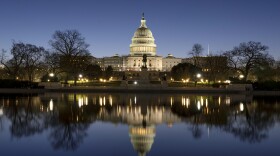San Diego State University boosters are promoting Measure G to allow SDSU to buy a sizeable portion of the Mission Valley stadium site to build an auxiliary campus.
SDSU officials have called the initiative the opportunity of a lifetime.
That opportunity has its genesis in the abrupt departure of the NFL’s Chargers football team in January 2017. FS Investors had already been talking to Mayor Kevin Faulconer and San Diego State University officials about an ambitious redevelopment plan at the Mission Valley stadium site.
RELATED: SDSU Seeks To Buy, Lease Qualcomm Stadium Property
FS Investors investors unveiled a 3,000-page initiative just a few weeks after the Chargers decision. The plan would leverage the stadium site redevelopment to lure a Major League Soccer franchise here. SDSU was initially considering a partnership with FS Investors. One proposal had the university paying for half of the stadium construction costs in exchange for land to expand.
Curious about the other Mission Valley redevelopment proposal on the ballot? Click here to see more about Measure E, the SoccerCity plan for a massive redevelopment project in Mission Valley.
But that relationship soured in the early months of 2017. By summer the divorce was official. The school publically announced it was no longer negotiating with the now rival developers.
RELATED: SDSU Unveils Campus Expansion Plan For Mission Valley
SDSU was interested in the Mission Valley property, however, not just land for a stadium.
“There’s another 150 acres of property down there. Everyone wants to talk about the stadium, but we also want to talk about a place for San Diego State University to grow,” said John David Wicker, SDSU Athletic Director.
Friends of SDSU, a collection of school boosters led by former San Diego City Manager Jack McGrory, began working on its own initiative.
Their plan to open the door for a campus extension led to the creation of SDSU West, or what is now called Measure G.
The initiative gives the university an option to buy about 132 acres of the 166-acre Mission Valley property.
Measure G calls for the construction of a multi-sports stadium, office space, 4,500 housing units, hotel space and a promise to build a river park on city-owned land.
It was a vision drawn up by a local architectural firm Carrier Johnson.
That $3 billion vision was unveiled just before last Thanksgiving with the idea that the entire region would benefit from the school’s growth.
“Mission Valley represents a once in a lifetime opportunity to acquire a proximate property where we can grow,” said then-interim SDSU president Sally Roush.
The school’s vision included drawings and animations that are widely featured in the Friends of SDSU material promoting Measure G.
In one significant departure from the competing Measure E, the school’s plan has far less commercial retail space. That was no accident. The plan was designed to create a campus feel while having no impact on taxpayers.
“One of the very first things that Sally challenged me with is that this plan has to be financeable on a stand-alone basis with no reliance on tax dollars,” said John Kratzer, JMI Realty.

RELATED: San Diego State Eyes Private Partners For Mission Valley Development
That plan relies on public-private partnerships. University officials pointed to the Montage Development, a housing project just south of the main campus, as an example.
“In the public-private partnership, it is the developer who is developing that land and taking on all that risk,” said Eric Hansen is the school’s director of housing.
In exchange, Montage partner Capstone properties got a long-term lease on the property and locked in a single-digit rate of return on its investment for decades.
This particular project generates no property tax for the city, but university officials say the private-public partnerships in Mission Valley will generate tax revenue.
How much remains unclear, but the San Diego Taxpayer’s Association has completed an independent analysis of Measure E — SoccerCity — and Measure G — SDSU West.
“The fifth part of the report talks about tax revenue and fiscal analysis,” said Haney Hong, president and CEO of the association.
The group is not taking a position on which measure is best for San Diego.
“Our analysis shows that when you compare the two, SoccerCity results in more tax revenue for the city of San Diego,” Hong said.
Twice as much for the city’s general fund each year, according to the report.
The SDSU West initiative was also criticized by City Attorney Mara Elliott, who called it overreaching, but her move to have the measure removed from the ballot was rejected by the courts.
RELATED: Media Battle Over Redeveloping Mission Valley Stadium Site In Full Swing
Measure G backers are undeterred. SDSU West spokeswoman Katy Temple says the sweeping redevelopment plan is the best option out there.
“This is the best initiative for the region of San Diego because it will grow the campus in an open and transparent process and it will also grow the economy which means it will benefit the entire area for years and years to come,” said Temple.
Measure G backers want to give the university a chance to develop a campus-like environment in Mission Valley — one that includes a sports stadium, housing, classrooms and open space.
And the measure boasts a lot of supporters who have endorsed the SDSU West vision.
“We have a big coalition of support and endorsements. Which we’re grateful for and we want to take that to the next level and have them mobilize all their contacts so that we can reach as many, many, many people as possible,” Temple said.
The issue lands squarely in the hands of city of San Diego voters when they choose between Measure E and G next month.
The measure with the most votes over 50 percent passes. If neither reaches that 50 percent plateau, both would fail, leaving the city to consider an alternate future for the stadium property.







